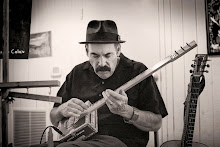Below is yet another review of The Tree People, this time by Stylus Magazine. Some of my thoughts on history and improvisation, topics brought up in the review: History never really stays the same, but changes as people's thoughts and references change in the present. It is fun to watch The Tree People regularly now mentioned as part of history because of a series of ongoing connections and events which started in the past but continue into the present and future. We are now working on getting a second
Tree People recording ready for reissue by Tiliqua later this spring. That album, Human Voices,was released in 1984, only on limited edition cassette. We have not been able to locate the master tapes, but fortunately I have always had the 2" original track tapes, with detailed hand written track sheets, that the engineer from that project, Don Ross of Eugene, gave me so long ago. I and original Tree People member Jeff Stier, with the help of my long time Portland engineer Dean Baskerville, have been remixing Human Voices at Dead Aunt Thelma's Studio here in Portland. It has been an interesting experience, and has opened me up to the idea that time travel is not just a science fiction concept, but a reality that we live every day. More on the remixing process in a future post.
Some of the new reviews coming in have a referred to The Tree People as an early jam band, a free form band, etc., and that is fine and good, but from my perspective as a musician and composer inside the group The Tree People,it is a little different. Almost all our pieces had a set structure and plan, but within that structure there was always room for improvisation, so each time a piece was played you might hear some some subtle differences, some different notes, different shadings, different ideas. Instrumental pieces and interludes would be more fertile ground for improvisation; vocal pieces and sections with written lyrics would be more tightly structured, but would stay fresh with different layers of meaning and emotion. Rehearsals were also part of the composition: we would try sounds and ideas out and collaboratively add to the creation of the pieces that way. Performances would also be a place where we would try things out, bringing the audience "being", with their active listening and participation, into the process, to see what works and continue to refine the work. And in the studio recording, which always seems to become the most focused and intense part of the the process, everything stands still for a moment, there is no past, present or future, all there is is the music.
So in some ways we were a jam band, in some ways not. I still find myself working in a similar fashion in my new work: working with good people who are good musicians, creating a structure that we can depend on, and letting good things happen.
The Tree People
Tiliqua
2006
A-
The forgotten legacy of the Tree People can be pretty accurately traced to one summer weekend in 1979 when Stephen Cohen, Jeff Stier, and Rachel Laderman, headed down to the secluded Rockin’ A Ranch Studio located somewhere in the backwaters of Oregon to record an album. Originally released as a limited run LP, the record slipped almost unnoticed into the dusty annals of history before Johan Wellens (owner and music archivist of Tokyo-based label Tiliqua records) salvaged the album from obscurity and re-released it on his own label. 28 years later, this long-neglected album flags up the telling historical debt that modern folk, in all its freaky derivations, owes to those early, unsung pioneers.
While Cohen’s voice and acoustic guitar predominate, the contributions of Stier (percussion, recorder) and Laderman (flute) are just as essential. They react to his playing almost instinctively. It’s a good thing: the album’s nine songs often feel as though the group is merely jamming around pretty loose structures. (The quietly terrifying “Opus” might exemplify the group’s sensitivity to each other’s tonal fluctuations best.) Even the structured hippy rumba of “Morning Song” still sees Laderman frolicking with abandon on her flute over the syncopated rhythm.
Perhaps as a result of their free-form approach, the tone of the album modulates between a dreamy acquiescence and a jagged purposefulness; the soothingly lyrical “Pot of Gold” and “The Pineapple Song,” the most structured pieces, contrast with the ad hoc violence of “Sliding”’s raw, steel-stringed riffs and raga-esque hand drum and the deliriously heathen cadenzas on “Space Heater” and “No More School.” These impromptu asides make listening to the album slightly unnerving, but hugely compelling—you never know when the next jarring slide or dissonant note is going to land.
Like the reissue of Vashti Bunyan’s Just Another Diamond Day in 2000, this re-release goes some way toward preserving the easily overlooked tradition of outsider / psych folk from sliding into the realm of self-perpetuating myth. But to appreciate this album from a historical perspective, as the mere totem ancestor to folkies like Devendra, Espers, Six Organs of Admittance et al., would be to do it a gross disservice. Of even greater value, The Tree People is an album of exquisitely crafted music, regardless of its undoubted historical import. Here’s to their Lookaftering.
Reviewed by: Paul Teasdale, Stylus Magazine
"The Tree People", a vinyl album recorded in a studio in the woods in Oregon in 1979, was reissued as a CD in 2006 by Tiliqua Records of Japan and as a vinyl record by Guerssen Records of Spain in 2008. Their 2nd album "Human Voices", recorded in 1984, was reissued by Guerssen in vinyl and as a CD in 2009. The 3rd and last Tree People album, "It's My Story" was released by Guerssen in 2010. This is their story.
